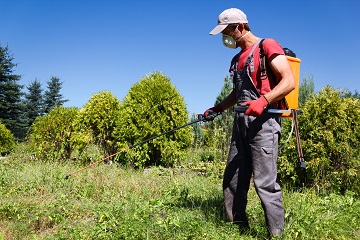NIOSH-funded Study Results in Improved Pesticide Testing Methods and Updated Regulations to Protect Agricultural Workers
May 2015
DHHS (NIOSH) Publication Number 2015-182
A Story of Impact:

Agricultural workers use pesticides to protect crops from insects, weeds, and other pests. However, these chemicals can cause serious health problems, especially if handled, applied, or disposed of improperly. Each year, physicians diagnose 10,000–20,000 pesticide poisonings among the estimated 2 million U.S. agricultural workers.1 When workers mix, load, apply, or dispose of pesticides, these harmful chemicals can enter the body through direct contact with skin, eyes, and clothes; eating or drinking pesticide-contaminated food or water; and breathing pesticide-containing mist, dust, fumes, or smoke.2 Exposure to some pesticides inhibits cholinesterase (ChE) – an enzyme necessary for communication between nerves and muscles. The brain and nerves are unable to control the movement of muscles. A low level of ChE can cause slowing of the heart, muscle paralysis, shivers, headache, convulsions, and coma. Pesticide poisoning is also associated with brain disorders such as Alzheimer’s disease.3

The Western Center for Agricultural Health and Safety (WCAHS) at the University of California Davis – funded by the National Institute for Occupational Safety and Health (NIOSH) – conducted research focused on accurately measuring blood levels of ChE in agricultural workers. ChE test results are used to determine if a worker is properly protected from pesticides (e.g., trained on pesticide safety, used required personal protective equipment, applied pesticide according to the label). A worker’s test results are compared to his or her baseline level of ChE, which is measured when the worker is not regularly handling pesticides. WCAHS found that the accuracy of ChE test results depended on the commercial clinical test kit used. Unreliable test methods can make it difficult to compare changes in ChE levels and identify workers with pesticide poisoning. Under the leadership of Dr. Barry Wilson, a researcher from the University of California Davis, WCAHS developed a standardized method for measuring ChE to reliably test for pesticide poisoning.4
Accurate ChE measurement is crucial in identifying and giving care to workers with pesticide poisoning. Early detection of low ChE levels and prompt treatment can help reduce the severity of the symptoms. Employers of pesticide mixers, loaders, and applicators in California are required to ensure each employee who regularly handles pesticides has his or her ChE level measured within three days after each 30-day work period. In 2000, the technique developed by WCAHS for measuring ChE became required in laboratories in California (California Code of Regulations, Title 3, Section 6728. Medical Supervision).5,6 Dr. Wilson’s research on standardizing ChE measurements improved the reliability and credibility of California’s ChE monitoring program.7,8 With accurate ChE measurements, employers can compare changes in blood levels and confidently identify workers with pesticide poisoning. Employers are required to remove employees with low ChE levels from the work site to prevent further pesticide exposure. Also, these test results can prompt employers to address gaps in worker protection to help avoid future incidents of pesticide poisoning.
The new method from WCAHS was a factor in the establishment of a formal ChE monitoring program in Washington.9 Similar to California, ChE tests are required for agricultural workers in contact with pesticides. ChE monitoring programs that use standardized lab techniques can potentially improve the health of an estimated 89,000 hired crop workers – who mix or apply pesticides – in California and Washington.10 This research from WCAHS has had a pivotal impact on state regulation and stands to influence agricultural programs throughout the country and better protect workers from pesticides.
- From 1990–2006, Dr. Wilson produced over 15 publications about the accurate determination of ChE levels and improvement in worker monitoring.
- WCAHS partnered with the California Department of Public Health Services, the U.S. Army Center for Human Health Promotion and Preventive Medicine, the National Institute of Environmental Health Sciences funded Center for Environmental Health Sciences, the Washington State Department of Labor and Industries, and the Department of Pesticide Regulation of the California Environmental Protection Agency.
![]()
![]()

![]()
References
- NIOSH [2013]. Pesticide illness and injury surveillance [https://www.cdc.gov/niosh/surveillance/pesticide/].
- Eldridge BF [2008]. Toxicity of pesticides to humans. In: Pesticide application and safety training for applicators of public health pesticides. Sacramento, CA: California Department of Public Health [http://westnile.ca.gov/special/category_a/?page=Chapter4.htm].
- Barry W. Wilson [1996]. Factors in Standardizing Automated Cholinesterase Assays. Journal of Toxicology and Environmental Health, 48:2, 187-196, DOI: 10.1080/009841096161429 [http://dx.doi.org/10.1080/009841096161429]
- National Academies of Science [2008]. Agriculture, forestry, and fishing research at NIOSH. Washington, DC: Committee to review the NIOSH Agriculture, Forestry, and Fishing Research Program, National Research Council.
- California Code of Regulations, Title 3, Section 6728. Medical Supervision. [http://www.cdpr.ca.gov/docs/legbills/calcode/chapter_.htm].
- Wilson BW, Sanborn JR, O’Malley MA, Henderson JD and Billitti JR. 1997. Monitoring the pesticide-exposed worker. Occupational Med 12(2):347-363.
- Wilson, B.W., J.D. Henderson, D.E. Arrieta, and M.A. O’Malley. 2004. Meeting requirements of the California cholinesterase monitoring program. International Journal of Toxicology 23(2): 97-100.
- Jack Henderson, Michael O’Malley, James Sanborn, Marylou Verder-Carlos and Barry Wilson. 1998. “Comparison of Acetylcholinesterase Assays Run under Conditions Specified by the Standard Ellman Method and Conditions Specified by a Commercial Cholinesterase Reagent Kit.” HS-1752, July 30, 1998, Department of Pesticide Regulation, Worker Health and Safety Branch.
- Harrington MJ (2002) Pesticide exposure monitoring. Agrochem Environ News 194:1–6.
- NIOSH [2014]. Internal analysis of the 2008-2010 National Agricultural Workers Survey and the 2012 Census of Agriculture. Morgantown, WV: National Institute for Occupational Safety and Health.
